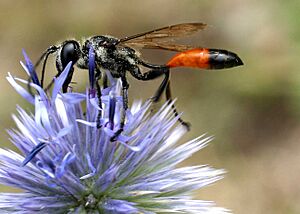Presociality facts for kids


Presociality is a way that animals behave. It means animals have close family relationships. They do more than just mate with others of their kind.
However, presocial animals do not form huge colonies. They are not like the very social, or eusocial, insects such as ants.
Presocial animals often live together. They also help take care of their young. They might share some tasks. But they do not have all three main traits of eusocial animals.
Eusocial animals have these three traits:
- Many generations live at the same time.
- There is a very strong division of labour. Some animals have special jobs. Some might even be unable to have babies (they are sterile).
- Older animals work together to care for the young ones.
Presocial behavior is much more common than full eusociality. Many animals show presocial behavior. Examples include canines (like wolves) that live in packs. Many insects, especially hymenoptera (like some bees and wasps), are presocial. Humans, many birds, and chimpanzees also show presocial traits.
Contents
Types of Presocial Behavior
Presocial behavior can be split into different types:
Subsocial Behavior
Subsocial means parents interact with their young. This is very common in the animal world.
- All mammals do this.
- Almost all birds do this.
- Many reptiles and fish do this.
- Quite a few insects also show subsocial behavior.
Parasocial Behavior
Parasocial means animals of the same generation live together. They also help each other.
Communal Behavior
In a communal group, each animal only cares for its own young.
Quasisocial Behavior
In a quasisocial group, animals work together to care for all the young. However, all members of the group can have babies.
Semisocial Behavior
In a semisocial group, only a few animals have babies. But this setup is not quite eusocial. For example, older and younger generations might not live together. Or the leader might only be in charge for a short time.
Why Wasps Are Presocial
Some wasps, like the Vespid wasps, show subsocial behavior. This happened because of dangers like predators and parasites.
It is safer for eggs and young wasps (grubs) if the mother wasp stays in her nest. She can watch over her larvae. It's even safer if other adult wasps stay with her. Then, these other adults need to find more food for everyone. This makes it much harder for parasites to attack the nest successfully.
Related Pages
Images for kids
-
The mouse lemur is a nocturnal, solitary-but-social lemur from Madagascar.
-
Giant honey bees cover the honeycomb of their nest.



